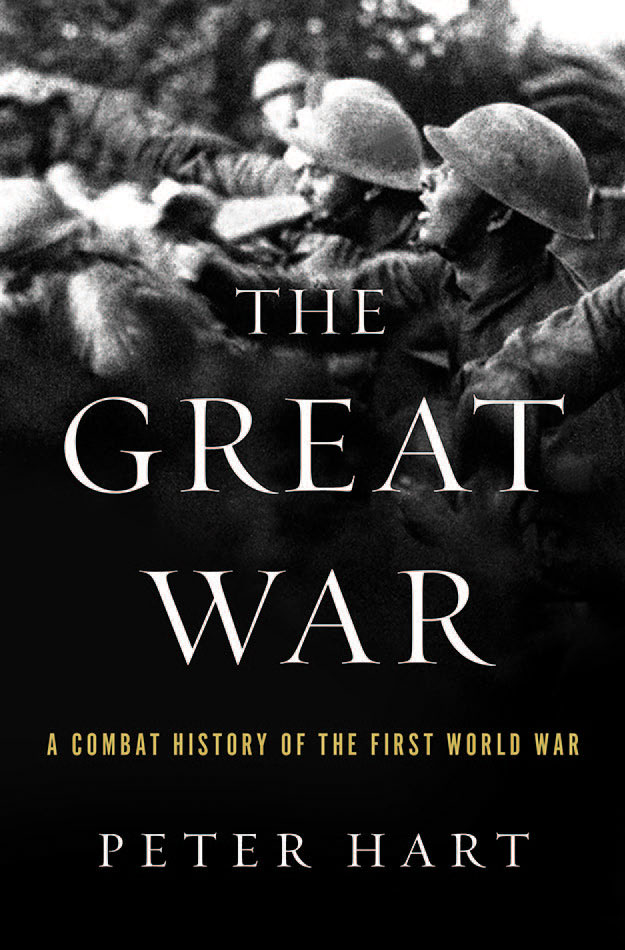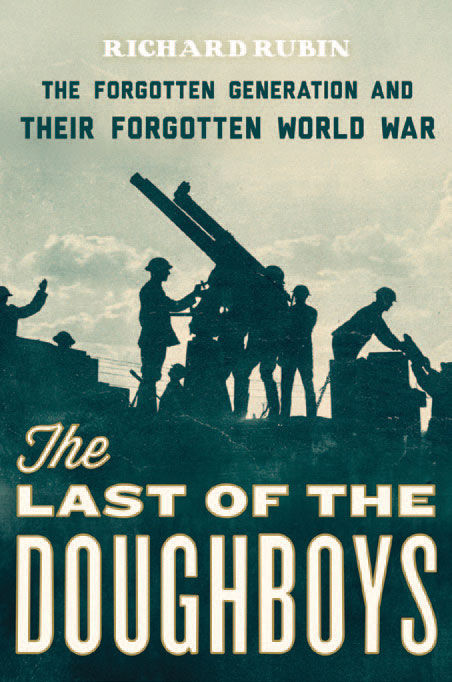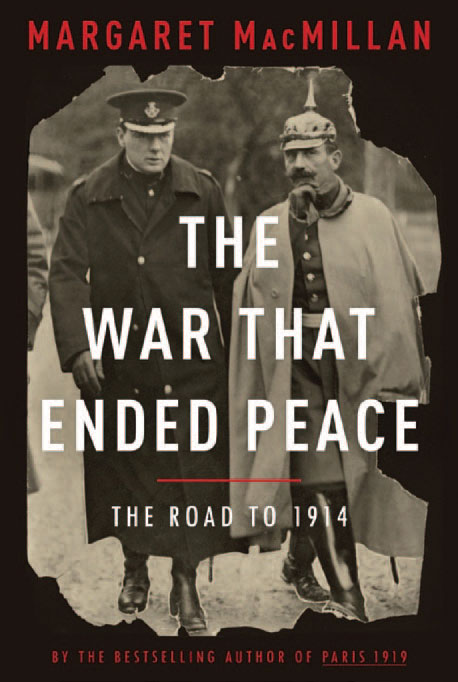Of War and Peace
The Great War: A Combat History of the First World War
Peter Hart. 2013. Oxford University Press, New York. 544 pages.
The Last of the Doughboys: The Forgotten Generation and Their Forgotten World War
Richard Rubin. 2013. Houghton Mifflin Harcourt, New York. 528 pages.
The War That Ended Peace: The Road to 1914
Margaret MacMillan. 2013. Random House, New York. 784 pages.
The Great War. World War I. The First World War. The War to End All Wars. Regardless of what it’s called, the conflict that shook the world between 1914 and 1918 still demands our attention a century later. One reason may be the scale of the war, which was vast in terms of its geographical reach. Action took place on land, at sea and in the air, in France, Belgium, Italy, Serbia, Russia, Austria-Hungary, Turkey, Greece and the Middle East. In part because of colonialism, troops were drawn from even farther afield: Australia, New Zealand, Canada, Senegal, Algeria, India and more. Further, because of strategic aims and political alliances, nations such as Japan, Montenegro, Bulgaria and the United States were also drawn in. The full list of all those involved is extensive.
The war came at a time when the world was changing rapidly, boasting many new inventions and innovations. Together with modern methods of mass production, this ensured the industrialization of weapons. Thus it became a conflict unlike any before it, generating casualty figures of staggering proportions. Estimates vary, but by the war’s end from 8.5 to 10 million soldiers were dead and a further 21 million physically wounded; the mental scars are more difficult to number. In addition, millions of civilians were killed by military action or died from war-related famine and disease.
After the war a steady stream of memoirs appeared, many of them seeking to exonerate individuals or nations and apportion blame elsewhere. Since that time, countless texts have been written analyzing that period in history. Today, as the world marks the 100-year anniversary of the conflict’s fateful beginning, World War I continues to be fertile ground for authors. Three new offerings provide very different perspectives, and for a generation far removed from those events and seemingly no closer to true peace, they provide insight into a world at times startlingly different from our own—and yet all too familiar.
The Learning Curve
The first of these books is simply titled The Great War. Its author is Peter Hart, a historian at London’s Imperial War Museum, who has written extensively on the First World War and who acts as a guide to the battlefields on the Western Front and Gallipoli (in what is today Turkey).
The book commences with a consideration of events leading up to the war, then progresses through each phase—largely chronologically—focusing in turn on the various theaters of war. It is a comprehensive and detailed account that gives a blow-by-blow description of the major battles, the main protagonists, the tactics used and the personalities involved. The narrative is interspersed with letters, sometimes personal, often poignant, giving a real sense of the desperate conditions in which so many lived, fought and died.
One of the emerging themes in the book is the seesaw nature of much of the fighting. For example, on the Western Front in 1915, the French Tenth Army attacked along the hill of Notre Dame de Lorette, with the main thrust pushing for Vimy Ridge, which they gained; but the strong German counterattack meant it was lost again by nightfall. Hart explains, “The problem was becoming increasingly evident: the methodology employed to seize a tactical feature could also be used by the other side to reclaim it.” The result is that “the fighting degenerated into a murderous slog as the French battered their way slowly across the Notre Dame de Lorette Spur. This was a true slaughterhouse.”
Many had thought that when a general European war did come it would be short. Such an outlook did not take into account the stalemates that would occur as each side made improvements to tactics, weapons and troop transport, and funneled additional financial and human resources into the conflict, only to reengage with increased force and determination.
Hart draws out this fact in reference to the British army’s experience at the Somme in 1916. In the context of a planned artillery bombardment of German front lines, barbed wire defenses and gun batteries, he explains: “The British believed that they had digested the various lessons of the Allied 1915 offensives.” But there were complications: “They were learning but so were the Germans.” Thus, despite several days of heavy artillery fire, the barrage appeared to have caused more devastation than it actually did, the British progress in tactics being offset by improved German defense. When the men went over the top of their trenches and across No Man’s Land to face the enemy on the morning of July 1, the result was once again “an utter slaughter.” There were 57,000 British casualties on the first day of the Somme alone.
“The Great War was the single most important event of the twentieth century, shaping the world that we live in today. Yet it is often regarded as a pointless war; a catastrophic mistake fought for little or no reason.”
The Great War makes it clear that the parameters of war were constantly changing. Human ingenuity, so wonderfully employed on many occasions to create a better world, was here employed to destroy it. Hart makes frequent reference to the improvement in armaments—tanks, machine guns, battleships, airplanes—as well as in tactics, such as the creeping barrage, where artillery fire is laid down ahead of advancing troops as they cross No Man’s Land. The French army not only entered the war with a lack of proper tactical training and modern strategic insight, but the poilu, or infantrymen, were dressed in 19th-century uniforms: bright red trousers and blue jackets. The French army faced a steep learning curve, as did American forces when they entered the war in 1917.
Learning about war and warfare is now a largely accepted aspect of the human existence. It is reflected in our politics and international negotiations and is a major factor in the spending plans of governments around the world. Hart concludes by stating that the Great War “was not—and never was—a war to end wars.” Instead it “proved an efficient catalyst in sowing the seeds for the numerous conflicts which have disfigured human history ever since.”
Echoes of the Past
Offering a very different perspective on the war is Richard Rubin’s The Last of the Doughboys. Rubin writes for a variety of publications, including the New York Times Magazine.
His book focuses predominantly on the role of American troops during the First World War. It is less about the grand sweep of historical events and, as such, lacks a wider context to help inform readers about what happened and why. It does, however, provide a more intimate story based on interviews with some of the last of those who experienced the war firsthand. Although several had limited combat experience, their accounts help to draw out aspects of the war often overlooked; it was not all about trench warfare. The style of Rubin’s book is quite chatty, with the author frequently inserting himself into the narrative. Some may like this approach, although it tends to distract from the pathos of the subject matter.
“The Great War occurred at, and in many ways created, a great crossroads in the history of man. It changed the Western world—and much of the rest of the world, too—more than any other war had, or has.”
One of the veterans he interviewed back in 2003 was William J. Lake, who at the time was nearly 107 years old. Shortly before his 22nd birthday, Lake was drafted into the army and placed in the 91st Division, the 362nd Infantry Regiment, and specifically the Machine Gun Company. He arrived at the front on September 29, 1918. Orders for the 91st on that day were to advance regardless of the cost; for Lake’s regiment that meant crossing open fields subject to enemy fire from three sides.
Rubin explains that machine guns were high-priority targets because of the damage they did. The men who went to and from the supply depot fetching ammunition were targeted too; this was Private Lake’s job. Asked in the interview how he felt at the time, he replied: “It’s pretty scary, I’ll tell you, because you don’t know when you are going to get it. . . . You’d hear bullets hitting off, zipping all around.” He had a number of near misses, with shrapnel passing through his coattail two inches from his back, and the heel of his shoe being torn off by a bullet. Lake also gave an account of how on one occasion he was sitting two feet from another soldier who was picked off by a sniper. Rubin remarks: “He told this story several times over the course of our two-hour conversation, and though he never had anything new to add, he kept returning to it: They picked him instead of me.”
As part of his research for the book, Rubin visited some of the battle sites in France. Walking the fields with a guide, he came across bullets (probably from a German Mauser 98), cartridge clips, pieces of uniform, and an unexploded shell, which his guide reported to the police. Apparently a few people are still killed or maimed every year in France and Belgium by shells from the First World War. Rubin tells us, “The earth is constantly regurgitating the detritus of that war” and is expected to do so for another two or three centuries. The reason can be understood when one begins to comprehend the magnitude of the artillery fire used. During the initial bombardment at the Battle of Messines on the Western Front in 1917, 3,561,530 shells were fired at the German front lines, along with millions of bullets fired over the heads of the British troops once they started to advance. This was one army, on one occasion, in one battle, on one front. At the Battle of Verdun in 1916, it is estimated that the French and Germans dropped 20,000,000 shells on each other. No wonder there is still so much to be found.
And it is not just the artifacts of war that are uncovered, but human remains too. Some estimates put at 100,000 the number of men whose remains are still undiscovered. When they are found in France, they are taken to Douaumont, where there is a graveyard containing 15–16,000 marked graves as well as an ossuary holding the bones of around 130,000 unidentified casualties.
Another veteran that Rubin interviewed was Frank Woodruff Buckles. When he died in 2011 at 110 years old, he was the last known American veteran from the First World War. Rubin explains the significance of his death: “It creates additional degrees of separation between us and the event. . . . You can stroll upon a forest floor still dimpled with shell holes, poke around crumbling concrete bunkers, zigzag through shallowed trenches, fill a grocery bag with jagged shrapnel picked from a freshly ploughed field. None of it is anything like talking to someone who was there.”
The Road to War, the Path to Peace
These two books address only in passing why the war happened in the first place. This is where the third volume excels. The War That Ended Peace by Oxford history professor Margaret MacMillan is a detailed account of events leading up to the war, putting the decisions made by the various political and military leaders within their historical context. The scope is impressive, taking in, for example, domestic pressures and civil unrest facing individual countries; the need for economic and military alliances between nations; the role of colonialism and nations’ desire for prestige on the international stage; the growing impact of nationalism and militarism; and the influence of past disputes and how current crises were handled. The volume is broad and yet detailed, with an in-depth analysis of the decision-makers: the prime ministers, the foreign secretaries, the diplomats, the presidents, the royals, the military leaders, and so on. It is also a tale of mistakes, confusion, miscommunication and bad timing.
“Peace, of a sort, came in 1918, but to a very different Europe and world. . . . Weakened and poorer, Europe was no longer the undisputed master of the world.”
MacMillan shows clearly how Europe’s options narrowed in the decades before 1914, as well as the turning points that led to war. These include France seeking a defensive alliance with Russia over fears of German aggression and domination, along with Russia’s need for finances, largely borrowed from France. Other factors include Germany starting a naval race with Britain, in part due to the Kaiser’s disposition, and its efforts to break up the Entente Cordiale between France and Britain during the first crisis in Morocco, which backfired as the two nations actually drew closer together. MacMillan posits: “Europe’s subsequent serious crises—the Bosnian crisis of 1908, the second Morocco one in 1911, and the Balkan wars of 1912 and 1913—added to the layers of resentments, suspicions, and memories which shaped the relations among the great powers. That is the context in which decisions were taken in 1914.”
Early in the book the author invites readers to consider how wars happen and how peace can be maintained. She argues that there are similarities between our times and those prior to 1914, with revolutionary protest and aggressive religious movements, along with stresses between ascending and descending nations. She states: “Nations confront each other, as they did before 1914, in what their leaders imagined was a controlled game of bluff and counter-bluff. Yet how easily and how suddenly Europe went from peace to war in those five weeks after the assassination of the archduke.”
One fact that MacMillan overlooks in her quest for answers is that peace never really existed in the first place. If another world war were to start now, it would no doubt prove devastating for our planet. It is simply a matter of scale, however. Can we argue that we live in a peaceful world only on the basis that we do not face imminent annihilation? Surely that is a poor definition of peace. The world before 1914, like ours today, suffered from a lack of peace at all levels of society.
But this was true long before the outbreak of the Great War. More than 2,700 years ago the biblical prophet Isaiah made clear that peace simply eludes humanity: “The way of peace they have not known, and there is no justice in their ways; they have made themselves crooked paths; whoever takes that way shall not know peace” (Isaiah 59:8). And why this lack of peace? James, the brother of Jesus, asked and answered the question: “What causes quarrels and what causes fights among you? Is it not this, that your passions are at war within you?” (James 4:1, English Standard Version).
The human quest should not be just to avoid war on an epic scale. That strategy always has failed and always will fail. The way to peace starts on an individual level as we each determine to follow a way of life that leads to peace and allow our hearts of stone to be renewed by the One known as the Prince of Peace (Isaiah 9:6). For such a process to expand across the whole world, we will need to wait for the return of that Prince, also called the King of kings.
In the meantime, as Rubin notes in The Last of the Doughboys, the soldiers who fought in the First World War are all gone. The earth still gives up the dead on occasion, but the Bible foretells a time when the dead, no matter where, when or how they died, will be restored to life. In a vision of the future recounted by the apostle John, we are told that “the sea gave up its dead, and death and the grave gave up their dead” (Revelation 20:13, New Living Translation). Isaiah also talks of a coming resurrection to life, a time when “your dead shall live; their bodies shall rise. You who dwell in the dust, awake and sing for joy!” (Isaiah 26:19, ESV).
The Bible has much more to say about this time that lies ahead. Hart points out in The Great War that we continue to learn about war—that World War I, far from ending wars, actually planted the seeds of succeeding wars. But according to the Scriptures, a time is coming when this will no longer be the case. There will be new priorities, a new system of governance, and a new way of dealing with disputes. Then “many peoples shall come and say, ‘Come, and let us go up to the mountain of the Lord, to the house of the God of Jacob; He will teach us His ways, and we shall walk in His paths.’ . . . He shall judge between the nations, and rebuke many people; they shall beat their swords into ploughshares, and their spears into pruning hooks; nation shall not lift up sword against nation, neither shall they learn war anymore” (Isaiah 2:3–4).
Despite the atrocities and futility of war, there is hope for the future.




